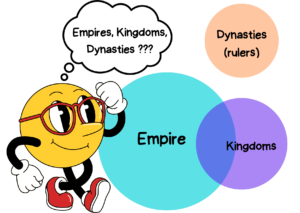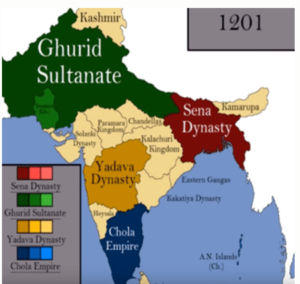Introduction
In the past, there have been numerous empires that included several kingdoms and were ruled by various dynasties. These three are connected on the one hand, while also having certain differences on the other. A dynasty can play a crucial role in both an empire and a kingdom. The terms “dynasty” and “empire” are more frequently used interchangeably, as in “Mughal empire or Mughal dynasty.” Similar to a kingdom, an empire is a state or nation governed by an emperor, respectively. Additionally, there are numerous ways in which these terminologies differ from one another.

What is an Empire?

An empire is a type of political system in which one state uses territorial conquests to expand and consolidate its dominance over a sizable territory while subjugating other states and nations, or a group of states and countries. An empire is often ruled by an emperor, however, there are instances in history where an empire has existed without a specific ruler. One such instance is the “British Empire” in India. In this approach, an empire is a group with a single sovereign authority and a centralised structure where the emperor had ultimate control. The idea of an empire’s emergence prepared the path for imperialism. In imperialism, nations dispatch a military expedition to other nations to build colonies.
What is a Dynasty?
A dynasty is a series of successive heads of the same family who rule over an empire or a kingdom. Primogeniture, or the idea that the eldest son of the king would inherit the throne, is typically the foundation of the succession process in dynasties. When a dynasty was deposed by members of another family or lineage, it came to an end. The dynasties are “hereditary,” meaning that rather than aptitude or skill, the powers are passed down through the generations depending on birth. The fact that a male is typically anticipated to ascend as the next monarch rather than a female shows how more “patriarchal” the idea of the dynasty was.
What is a Kingdom?
A kingdom is a country or area that is governed by an absolute monarch (a king or queen), who makes decisions that affect the entire country. A kingdom may be a portion of an empire, where the emperor may delegate control of a particular territory to any of his kin. Multiple dynasties may succeed a single kingdom, although a kingdom cannot be exclusively connected with one dynasty. For administrative purposes, the kingdoms are further divided into provinces, where several officials are appointed and used to report to the monarch.
The idea of a kingdom originated in India during the later Vedic period, when janapadas, a tribal society, evolved into mahajanapadas and were eventually referred to as a kingdom. As numerous kingdoms began to compete for power, continual conflicts began.
What is the difference between an Empire, Dynasty and Kingdom?
| Empire | Dynasty | Kingdoms |
| A political entity ruled by an emperor is an empire. | A succession of kings from the same family or bloodline is referred to as a “dynasty.” | A kingdom is a territory under a king or queen. |
| A wide area of land was made up of an empire. Even a few kingdoms could belong to an empire. | A dynasty has nothing to do with the geographic area. Rather a dynasty rules over a empire or kingdom. | The size of a kingdom might vary depending on its territorial scope. |
| Someone who may or may not be related to the ruler rules an empire. | Regardless of the circumstances, a dynasty is always made up of members of the same family. | A monarch may be chosen by the members of a certain key official and group or may inherit the throne from his or her family. |
Examples-Ancient India
- The first indigenous empire of India, the Empire-Mauryan Empire, ruled over the whole Indian subcontinent from 321 BCE until 185 BCE.
- The Gupta Empire, often known to rule during the Golden Age of Indian history, ruled over what is known as ancient India from the fourth to the sixth centuries BCE.
- Several dynasties, including the Nanda, Haryanka, Pandya, Pallava, Maurya, and Sunga dynasties, existed in ancient India.
- Kingdom- Magadha was one of the illustrious kingdoms of prehistoric India.
- There were several other kingdoms present during the period, including Avanti, Vatsa, Kosala, Kuru, etc.
Summary
A political entity ruled by an emperor is an empire. A succession of kings from the same family or bloodline is referred to as a “dynasty.” A kingdom is a territory under a king or queen. The first indigenous empire of India, the Empire-Mauryan Empire, ruled over the entire Indian subcontinent from 321 BCE until 185 BCE. There were several other kingdoms present during the period, including Avanti, Vatsa, Kosala, Kuru, etc.
Frequently Asked Questions (FAQs)
1. Why was the Gupta Period called the Golden Age of India?
Ans. Economic prosperity and outstanding accomplishments in the fields of science, technology, art, architecture, literature, mathematics, religion, and philosophy were witnessed throughout this time. The Gupta era is therefore known as the “Golden Age” of Indian history.
2. Is there any Country in the World which is still Ruled by Kings and Queens?
Ans. Yes, there are 44 countries in the world which have a monarchial system of governance. Where a monarch is considered as the head of state. United Kingdom, UAE, are popular examples.
3. Do we have an Empire or Kingdom Existing in India Today?
Ans. No, there is no longer an empire or kingdom in India. Now that we have a democratic system of governance, those who labour for the general benefit of the populace directly or indirectly elect the nation’s leaders.

